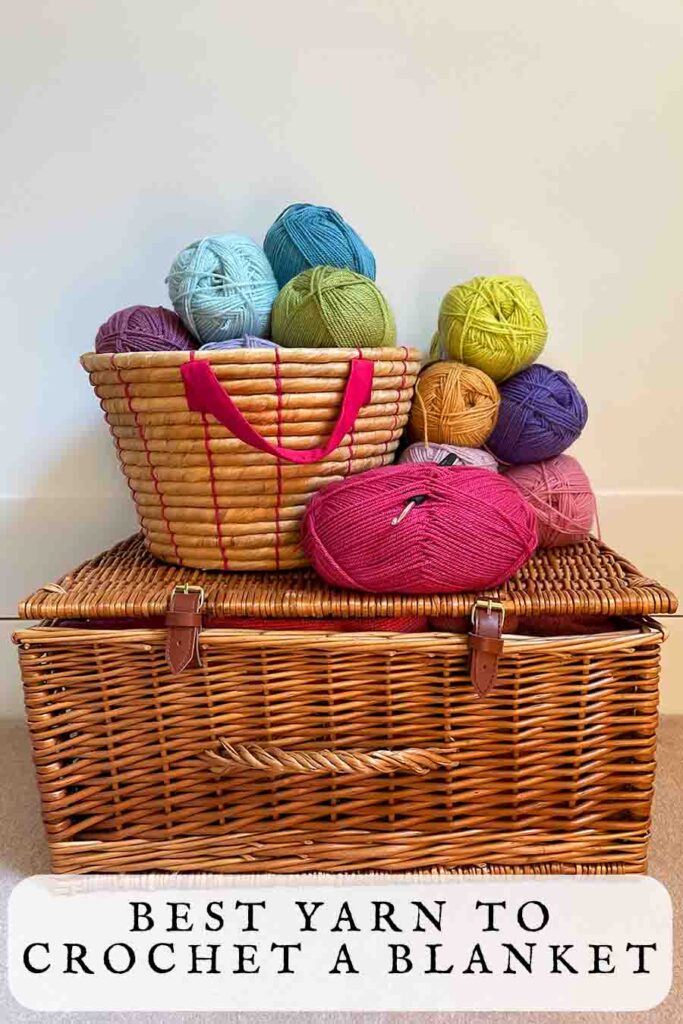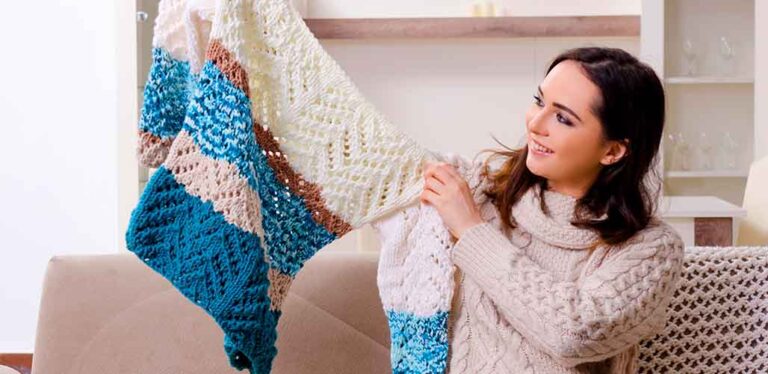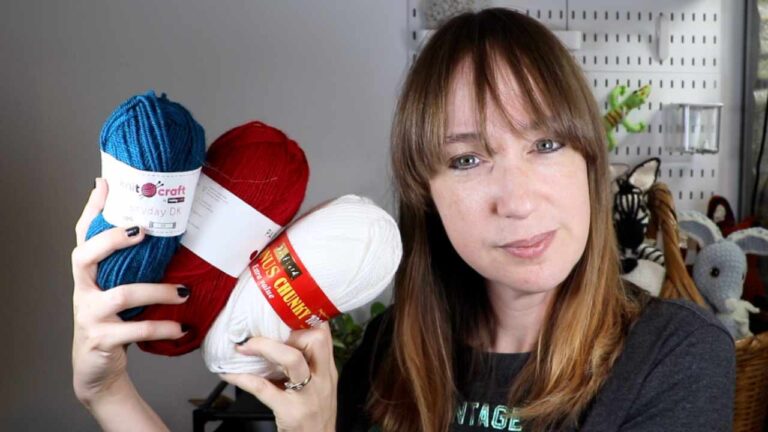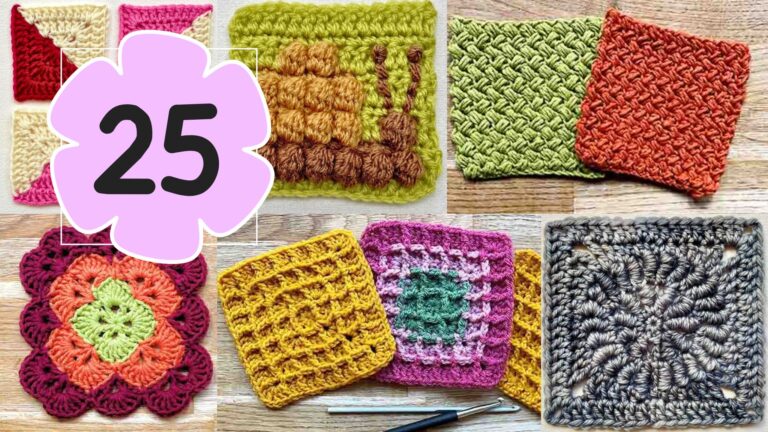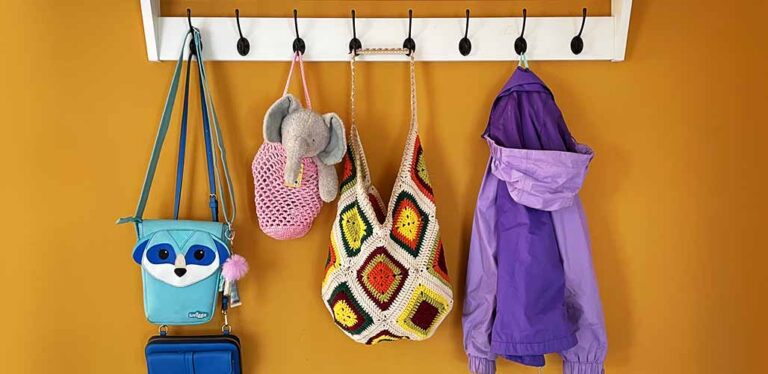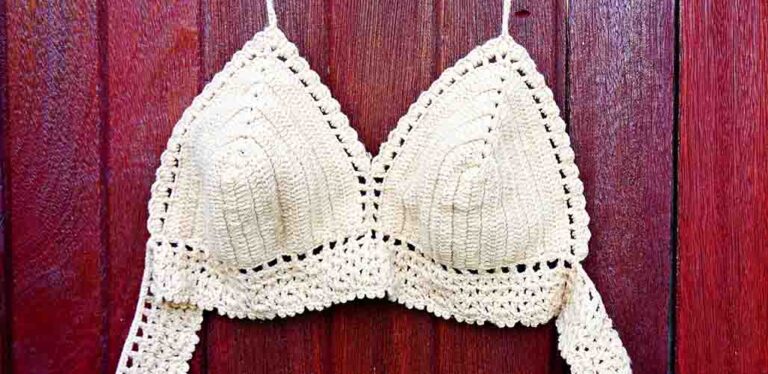Best Yarn To Crochet A Blanket – Fibers For Every Occasion
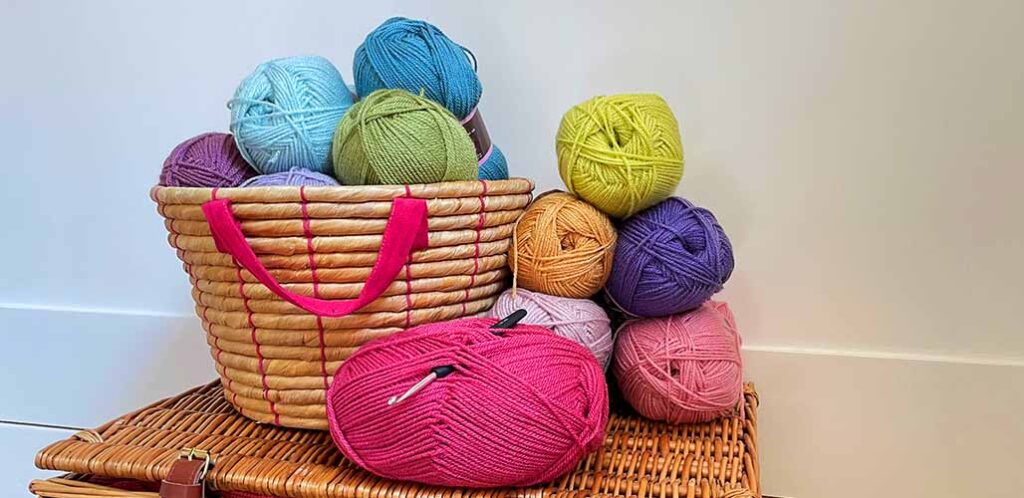
Choosing the best yarn to crochet a blanket is a nerve-wracking part of getting started. Realising you’ve made the wrong choice half way through such a big project doesn’t even bear thinking about! Once you have experience using a handful of different yarns, you’re sure to form a preference for particular weights, fibers, and even brands, based on their finish, and their feel as your work with them. But if you’re struggling to work out which yarn to try first, I’m going to guide you through the properties you might want to prioritize. And I’ll recommend some tried and tested favorites, based on your choices.
- Choosing the best yarn to crochet a blanket
- What to look for
- 16 of the best yarns for crochet blankets
*The products linked in this post were carefully selected by Lucy Kate Crochet. If you decide to purchase using the links provided, we may earn a small commission on that sale. This is at no extra cost to you.
Choosing the best yarn to crochet a blanket
I’ve been crocheting for over 10 years, and I’ve definitely found a comfort zone when it comes to choosing yarn for blankets. Having a confident idea of which yarn will work well for my next blanket is great, because I can dive in knowing that the results will look good, and last well. Lots of yarns have the potential to work for blankets, but some are better suited to specific projects than other. What’s more, us crocheters are all unique – size and textures of wool that I love working with might not be the same as the ones that inspire you!
Experimenting with different fibers and trying out many different kinds of pattern are the best ways to find your own favorite blanket yarns. But if you’re making your first blanket, or even a new kind of blanket, for the first time, coming up are some things to look for when you choose your yarn. And in the following section, I’ve organized 16 recommendations so that you can see how they compare.
What to look for
When choosing the best yarn to crochet a blanket, here are the properties you’ll want to consider:
- Weight
- Fiber
- Pilling potential
- Color palette
- Cost
Weight
Let’s start with an important creative decision. Do you want to make a thick, plush blanket, or something more lightweight? If you have been spurred into action by pictures of other people’s projects, then you might already have an idea of the answer to this. But if not, here are some advantages and disadvantages of thick vs thin yarns.
Thick yarns are also known as bulky (size 5), super bulky (size 6) and jumbo (size 7) yarns. Lots of yarns in these categories are specifically marketed for making blankets from. You need to know that:
- They are quick to work with – thick yarn means big stitches, and fewer stitches to complete per square inch.
- Lots of beginners find thick yarns easier to manipulate.
- The results are dense, warm and snuggly.
- Since you can produce a large area of crochet quickly, bulky yarns are great for making a blanket big enough to cover a king size bed.
At the other end of the scale, DK (size 4) and worsted (size 5) yarns are popular for making more lightweight blankets. Some baby blanket patterns even use sport weight (size 3) yarn.
- Lightweight yarns require more stitches per inch than heavier yarns, so there’s more work to do and your project will take longer to complete.
- There is a much wider choice of different fibers and textures available, including sustainable natural fibers like bamboo, and luxury blends with ingredients like cashmere for extra special projects.
- Blankets in lightweight yarns have more potential for decorative detail, because the stitches are smaller.
Fiber
Next, what fiber will work best for your blanket? Synthetic fibers like acrylic are popular because they are economical to buy in bulk for large projects, come in a huge number of colors, are machine washable, and color fast. At the other end of the spectrum, luxury yarns made from 100% premium materials like merino wool or a cashmere blend can turn a simple blanket into an extra special gift, or an heirloom worthy of treasuring forever. In between, there are lots of wool blend yarns, that combine the warmth and appeal of natural fibers, with the practical benefits of a synthetic material. Finally, cotton yarns are another popular choice. Cotton fiber is heavier and less than squashy than wool or acrylic, but it is hardwearing and shows great stitch definition.
Pilling
Pilling is the enemy of the crochet blanket. Lots of fibers pill to some degree, and I try to remind myself that it’s a sign of a blanket which is well loved and used, rather than fighting against it. Some manufacturers also make yarns which they specifically describe as anti-pilling. I’ll admit right now that I haven’t tried any of them yet, but if you want to (and there are a couple of examples below) then please leave us your thoughts about them in the comments box later!
Color palette
If you already have a vision for the color palette of your blanket, then you’ll need to prioritize choosing a yarn which is available in all those colors. On the other hand, if committing to a color scheme is causing you almost as much stress as choosing a yarn, then picking a product which comes in a small number of colors that all complement each other already will solve two creative conundrums in one go!
It’s also a good idea to bear in mind that some yarns are more likely than others to vary in color between dye lots. For example hand dyed yarns, and yarns made entirely of natural fibers. If you can’t afford to buy all the yarn you need in one go, you might prefer to use a synthetic, mass-produced yarn, which is more likely to look consistent each time you buy some more.
Cost
You don’t need me to explain why cost is important we all have a budget to work within! To help you choose the best yarn for a crochet blanket project, I’ve tried to include an indication of the relative price of my recommendations in the next section.
16 of the best yarns for crochet blankets
Here are 16 yarns which all have the potential to work for blanket projects
| Synthetic | Wool blend | Cotton | Premium | |
| Light weight | Scheepjes Color Crafter $ | Scheepjes Merino Soft $$$ | Lion Brand 24/7 Cotton $ | Sirdar Snuggly Cashmere Merino $$$$ |
| Medium weight | Premier Everyday Anti-Pilling $ | Paintbox Wool Mix Aran $$ | Lily Sugar’n Cream $ | Willow Dusk $$$ |
| Bulky | Bernat Blanket $ | Bernat Symphony $ | Bernat Maker Home Dec $ | K + C Roving Yarn $$ |
| Super bulky | Bernat Blanket Extra, or Blanket Big $$ | Yarn Bee Effortless Super Bulky $ | Darn Good Yarn Cotton T-Shirt $$$$ | Morehouse Bulky $$$$ |
Scheepjes Color Crafter, $
Color Crafter is 100% acrylic*, and comes in an absolutely whopping 93 solid shades, which makes it the perfect choice for blanket projects with lots of tonal color variation, such as temperature blankets.
The balls are generously-sized, and friendly on your purse. What’s more, Scheepjes promise this yarn is anti-pilling, so you can use it and wash it over and over again.
Scheepjes Merino Soft, $$$
Merino Soft is spun from 50% merino, 25% microfiber and 25% acrylic*, so it is warm, soft, light, and durable. It’s available in 56 irresistible colors, which are all named after famous artists.
This is my go-to yarn for baby blankets that I hope will be both used and enjoyed, and also loved enough to keep for younger siblings and even future generations.
Lion Brand 24/7 Cotton, $
24/7 Cotton is a versatile cult classic among crocheters. It’s 100% mercerized cotton*, which means it has been chemically treated to make the fibers more smooth and supple. The result is a yarn that’s easy to use, produces excellent stitch definition, and still drapes beautifully.
It comes in over 30 colors, but really shines when you use a limited color palette and play with different stitches to create texture instead.
Sirdar Snuggly Cashmere Merino, $$$$
Sirdar yarns come from Yorkshire – one of the oldest wool making regions in the world! Snuggly Cashmere Merino* is spun from 57% Wool 33% Acrylic 10% Cashmere, to give it an extra special touch.
The color palette is quite muted and limited, but the addition of some acrylic keeps it washable – so this is a great choice for a christening blanket, or a gift for a new baby.
Premier Everyday Anti-Pilling, $
Everyday Anti-Pilling yarn* is a great alternative to Color Crafter if you prefer worsted weight yarn to DK. It’s 100% acrylic, boasts anti-pilling technology, and comes in 66 colors from delicate pastels to super-saturated neons.
Best of all, it’s tried, tested, relied upon and recommended by thousands of other crocheters, so you know it’s not going to let you down.
Paintbox Wool Mix Aran, $$
This worsted weight wool mix is 50% wool and 50% acrylic*, for a perfect balance of warmth and washability. Paintbox are known for their colors, and this yarn comes in 48 easy to mix-and-match shades which take the headache out of planning a colorful granny square blanket.
Everyone has their own idea of which yarn has the exact right combination of properties for crocheting blankets, and for me, this is it.
Lily Sugar’n Cream, $
Sugar’n Cream is America’s most popular cotton yarn, and it’s easy to see why. It comes in a dazzling range* of solid, ombre, prints, and self-striping shades, all spun from 100% cotton grown in America. It’s hardwearing and long lasting, but it isn’t mercerized, so it’s less supple and bouncy than the other cotton yarns on this list.
Willow Dusk, $$$
Dusk yarn from Willow combines 80% wool with 20% super-soft alpaca fibers, for extra warmth and softness. It comes in a limited color palette of 12 beautifully muted shades that all work well together. Crochet blankets made from this yarn make extra special gifts for loved ones, and working with alpaca hair will be a pleasure for you too!
Bernat Blanket, $
Bernat brand yarns* have been available for years, but the introduction of their Blanket yarn *has raised their profile through the roof. This affordable 100% polyester yarn makes the softest blankets you will ever touch, and stands up well to washing. The thickness offers a good balance between being quick to work up, and narrow enough to play with pattern using it’s incredible 70-strong color palette.
Bernat Symphony, $
Symphony is a chunky, fuzzy*, 80% acrylic and 20% wool yarn. In technical terms, it’s a lightly brushed roving yarn, which means the fibers have only been loosely twisted together, and then combed slightly to tease out lots of little wispy bits. Blankets crocheted from this yarn are exceptionally warm and soft to touch, but nearly impossible to unravel if you make a mistake, because the wispy bits knot together. So if you’re not feeling confident, save this for another day!
Bernat Maker Home Dec, $
We’ve talked about how cotton is heavier than wool or acrylic. This presents a problem if you want to make a blanket with bulky cotton yarn, because it could end up weighing a lot. Well, Bernat have offered a solution in the form of Home Dec*, which has a tubular cotton exterior, and a nylon core. It’s attractive and eye-catching, not to mention washer and dryer friendly. But unfortunately it does only come in 16 shades, of which only 8 are solids.
K + C Roving Yarn, $$
Another loosely-twisted roving yarn, this time made from 100% wool. It only comes in 12 chic colors, and blankets crocheted from this yarn are dense, squashy, and luxurious. They deserve to be draped over a sofa next to a beautiful fire place, and have their picture posted all over social media. They are also hopelessly impractical and pill as soon as you use them, but I don’t care – this yarn is a beauty.
Bernat Blanket Extra, or Blanket Big
First came Bernat Blanket, then came its big brother Blanket Extra*, and it’s even bigger brother, Blanket Big*. These are the yarns for you if you want to get playful with scale, or make a king size blanket in a day. They’re both 100% polyester, and produce crochet with a chenille-like feel to it.
Yarn Bee Effortless Super Bulky, $
Yarn Bee from Hobby Lobby is a well-established brand boasting dozens of products, but let me draw your attention this 76% acrylic, 20% alpaca and 4% rayon super bulky yarn specifically. It comes in a limited palette of nature-inspired dyes, and it’s perfect for making soft, sophisticated blankets quickly!
Darn Good Yarn Cotton T-Shirt, $$$$
Darn Good Yarn are a company with a mission to produce sustainable luxury yarns, and promote ethical working practices. This bulky yarn is made from ribbons of rescued pima cotton leftover from t-shirt manufacturing. It’s 90% cotton, 5% viscose and 5% elastane, soft, highly washable, and keeps material out of landfill.
Morehouse Bulky, $$$$
Morehouse Farm’s bulky yarn is made from 100% plump merino wool. It comes in 21 shades covering bright and muted tones, and makes short work of even large blankets. If you have the budget and want to treat yourself to something special, you can’t go wrong with this yarn. Treat your blanket carefully though, and always wash it by hand!
Choosing the best yarn to crochet a blanket
Blankets are big projects. Even using bulky yarns, they represent a significant investment of time, money and effort. There are a huge number of yarns you could use, but I ultimately have one simple philosophy about making the final choice:
The best yarn to a crochet a blanket from is one you won’t get sick of looking at, half way through.
So start with a spark of an idea that excites and inspires you, and keep hold of that when you make the rest of your choices. There might be some compromises you have to make in other areas (for example compromising fiber content for the right color palette), but the original spark will keep you motivated to finish your project, and the result will always be something you love. Enjoy!
*The products linked in this pattern were carefully selected by Lucy Kate Crochet. If you decide to purchase using the links provided, we may earn a small commission on that sale. This is at no extra cost to you.
